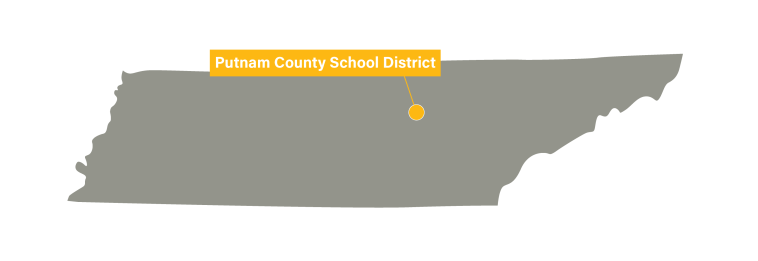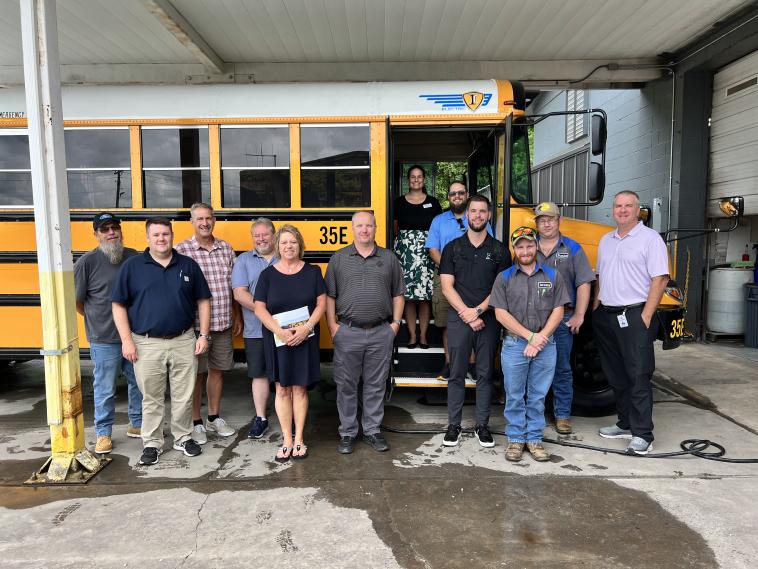In Rural Tennessee, a Supportive School Bus Dealer Met an Enthusiastic School District. The Partnership Has Been Electric.
Putnam County Schools worked closely with their local school bus dealer to bring clean rides to mountainous terrain.

In the fall of 2022, Putnam County Schools, a rural district located in central Tennessee, received funding through EPA’s Clean School Bus Program (CSBP) for its first two electric school buses. But the district wasn’t going on this journey alone.
Putnam County partnered closely with its school bus dealer, Cumberland International, which helped navigate the process and get the electric school buses on the road. This cooperation was key to Putman County’s success so far, and thanks to this support and the smooth rollout of the electric school buses, the district is looking to bring more ESBs – and the benefits they provide for students – to its fleet.

About half of Putnam County Schools’ 12,000 students rely on school buses for daily transportation. The district’s transportation department, supervised by Ron Chaffin, operates a fleet of 80 school buses running 60 daily routes, including some crossing mountainous terrain. The two electric school buses have been operating successfully since August 2023, and the district is interested in adding more to the fleet in the future.
Why Putnam County Schools chose electric school buses
After the U.S. Environmental Protection Agency (EPA) opened applications for the first round of CSBP funding in mid-2022, partners across Tennessee organized to connect with school districts about the program.
The regional electric utility Tennessee Valley Authority (TVA), nonprofit Drive Electric Tennessee, Tennessee Department of Environment and Conservation, and WRI’s Electric School Bus Initiative joined together to create Tennessee Bus Electrification, Education and Planning (TN BEEP), an outreach effort to connect with every district in the state, assess district needs and concerns, and provide education and resources on school bus electrification. The TN BEEP partners contacted every district in the state and convened webinars and events to showcase successful electric school bus deployments and demystify electric vehicle charging and rates.

When the EPA opened applications, the agency also released a list of priority school districts based on income level, rural status or Tribal district designation. With nearly 40% of the population in Putnam County considered low-income, the school district was considered an EPA priority district and had access to high levels of funding and prioritization in the application process.
Ashley Scurlock, a bus account manager at Cumberland International, an IC Bus dealer in Tennessee, reviewed the EPA’s priority list for CSBP funding and reached out to local districts on the list to see if they’d be interested in applying. Putnam County Schools was at the top of Scurlock’s outreach list. She also connected with the Tennessee Association of Pupil Transportation to hold an electric school bus demonstration for priority applicants. Through Scurlock’s proactive work, she has helped over 10 school districts to secure electric school bus funding.
| Putnam County Schools | |
|---|---|
| Location | Putnam County, TN |
| Number of students | 12,000 |
| Number of schools | 22 |
| Number of students who ride the bus | ~6,000 |
| Fleet size | 80 school buses |
| Number of electric school buses in fleet | 2 electric school buses |
With Putnam County being on the EPA’s priority list, Scurlock also contacted Chaffin directly to see if the district had any interest in applying for funding. Chaffin attended the electric school bus demo and saw the program as an excellent opportunity to take advantage of money on the table and to be at the forefront of the electric school bus transition.
Chaffin and Scurlock then worked together to get approval to apply for CSBP funds from school district officials and the school board. When the pair presented the opportunity at a school board meeting, the board immediately expressed interest and curiosity. The board asked Chaffin and Scurlock so many questions that the meeting went over time.
“Our school board meetings are never that long, but when we started talking about electric buses, they were all ears,” Chaffin said. “We have a board that is all about learning.”
Over the past 12 months, the monthly average to power both electric school buses has been $350. Chaffin calculated that, for the same period, the average cost for the diesel fuel for both buses would be around $1,000.
Partnering for successful implementation
Once school district officials and the board had approval to apply for the CSBP rebate, Cumberland applied for the rebate on behalf of the district, and they received notice of their rebate award at the end of 2022. That’s when the work of acquiring the electric school buses and getting them on the road began—and once again, the partnership between the school district and the dealer was crucial.
After being awarded funding, district staff ordered the electric school buses from Cumberland and began to prepare for their arrival.
Scurlock explained that it was a learning process, but open communication throughout the journey was essential to successful deployment of the buses.
“I told [Chaffin] that there are going to be hiccups, there are going to be challenges,” Scurlock said. “But I’m going to be honest and tell you when there’s an issue, and then I’m going to figure it out.”
“All of my CSBP rebate recipients are saying ‘I want more!’ If you would have told me that this would happen in Tennessee, as die-hard diesel as we are, I wouldn’t have believed you.”
- Ashley Scurlock, Bus Account Manager at Cumberland International Trucks
To get the electric school buses on the road by the beginning of the 2023-2024 school year, there were a few steps that Cumberland and Putnam County needed to accomplish together.
Scurlock worked with the school board to have a signed purchase order sent to the EPA. Once the EPA approved the order, it was submitted to Cumberland in the spring of 2023. In the meantime, Scurlock gathered information about Putnam County’s current routes to determine which would make the most sense for the first electric school buses. Putnam County’s electric utility, TVA, taught Scurlock about the best times to charge, information that she then used to identify which of the district’s routes would be the best fit for the electric school buses while aligning with the school districts need for 10% of the fleet being spare buses. The school district ended up putting the electric school buses on two of their longer and more extreme routes to test their performance.
While Scurlock coordinated the installation of Putnam’s two chargers, Chaffin set out to determine which of his bus drivers would be assigned to the new buses. Before the new school year began, two drivers who were excited about the technology enthusiastically volunteered – including one who said it “would be one of the most fascinating things” he’s ever done.
What’s the latest?
Cumberland delivered the two IC Bus electric school buses in July 2023, and the new buses have been operating every day since the first day of the school year in August 2023. And thanks to the continued partnership between Scurlock and Chaffin, the clean electric school buses have proven reliable and effective.
The school district has also experienced large cost savings. Over the past 12 months, the monthly average to power both electric school buses has been $350. Chaffin calculated that, for the same period, the average cost for the diesel fuel for both buses would be around $1,000.
Scurlock regularly monitors the electric school buses — which she affectionately calls “Steve’s bus” and “Derek’s bus” after their drivers — through a telematics smartphone app, an app that uses your phone’s sensors and GPS to track your driving behavior, like breaking and accelerating. She also regularly checks for maintenance and charging issues to ensure any problems are addressed as soon as possible.
Advice for other school districts
Chaffin stressed the importance of working with a dependable school bus dealer who is communicative, knowledgeable and willing to provide support every step along the way, and other partners can also smooth implementation. TVA was also critical to ensuring that the charging infrastructure was installed and costs were managed. Now, the district is partnering with the mechanical engineering department of a local university, Tennessee Tech, to explore how the data from the buses can be used to continue to learn about their value and use in the district.
Scurlock emphasizes the value of dealers supporting their school clients. She saw an opportunity for districts in her region and brought it to their attention. In fact, she submitted over 50 applications to CSBP for school districts across Tennessee. But she says the crucial element was the enthusiasm and collaboration she saw from districts.
“All of my CSBP rebate recipients are saying ‘I want more!’” she said. “If you would have told me that this would happen in Tennessee, as die-hard diesel as we are, I wouldn’t have believed you.”
For years, one driver had headaches due to the exhaust fumes from their diesel-burning school bus. Now, those headaches are gone thanks to the zero-tailpipe-emissions electric school buses.
The drivers have said that they love the buses — and so do the kids. For years, one driver had headaches due to the exhaust fumes from their diesel-burning school bus. Now, those headaches are gone thanks to the zero-tailpipe-emissions electric school buses.
Chaffin and Scurlock take the electric school buses to parades, expositions and sporting events to show them off whenever they can.
“We are really working very hard to show the public that, hey, these things really do work,” Chaffin says.
Since the rollout has been so successful, Chaffin hopes to use funding opportunities to bring more electric school buses to the district and deliver a clean ride for more students.